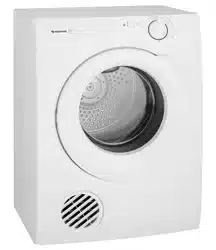Documents: Go to download!
User Manual
- User Manual - (English)
- SDV457HQWA - Simpson - Specifications Sheet - (English)
- Installation Guide - (English)
- INSTALLATION INSTRUCTIONS
- Quick 5 Step Operating Guide
- Useful Hints
- TROUBLESHOOTING
- CLEANING THE LINT FILTER
- DRYING GUIDE
- INSTRUCTIONS FOR WALL MOUNTING YOUR DRYER
Table of contents
User Manual Dryer
INSTALLATION INSTRUCTIONS
You can choose to put your dryer:
- on the floor.
- on a workbench, on a wall, upside down or upright, using the included mounting kit.
- on top of a front load washing machine using a stacking kit available as an optional extra (not available for all washing machine models).
The appliance must not be installed behind a lockable door, a sliding door or a door with a hinge on the opposite side to that of the tumble dryer in such a way that a full opening of the tumble dryer door is restricted.
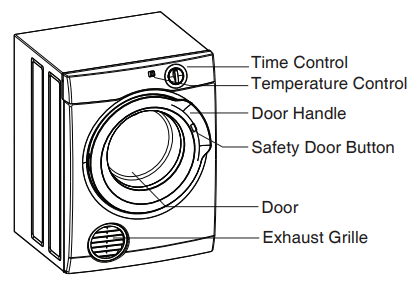
The exhaust grille has a range of positions. which allows you to select the optimum exhaust air angle. Simply hold the grille and rotate it until it hits the built-in stop.

Do not install your dryer in a cupboard or small un-vented laundry unless you are using a venting kit.
There are 2 VENTING OPTIONS
- front
- rear-using a venting kit (optional extra)
Venting Kit (Optional Extra)
- DVKOOSK - Through the wall
- DVKO06 - Universal flexible hose
Important: Use only kits approved by Electrolux Home Products Pty. Ltd. with your dryer. Contact the
Electrolux Home Products Pty. Ltd. Spare Parts Centre for the list of approved kits. The exhaust duct must not exceed 2 meters in length at 100mm diameter. If connecting the dryer to a common ducting system, safety advice should be requested from the manufacturer.
If you choose to use the optional vent kit, the exhaust grille at the front of the dryer will need to be replaced with the outlet cover from the back of the dryer. Gently prise open the grille, using a thin-bladed tool. Next, remove the cover from the back and clip it into the grille space at the front. The exhaust grille is not required when using a vent kit.

You can position the vent kit at the back of the dryer to remove air sideways.
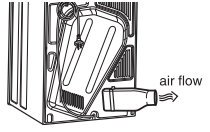
Inlet and outlet points need clear airflow to prevent overheating. so ensure there is adequate ventilation. (ie. open window or external door.)
If a venting kit is used and the exhaust is discharged out of the room. there must be adequate ventilation to avoid the back flow of gases into the room from appliances burning other fuels, including open fires, when operating the tumble dryer. This is not applicable where a venting hose is directed to an open window. The exhaust air must not be discharged into a flue which is used for exhausting fumes from appliances burning gas or other fuels.
Quick 5 Step Operating Guide
1. Load your dryer loosely until it is no more than TWO THIRDS FULL. Clothes must tumble freely in a dryer. Don't cram them in. Wetclothesfluffup when dry.
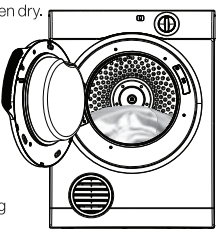
Overloading will:
- Reduce efficiency
- Increase drying time
- Increase the risk of creasing
Do not load clothes or other articles which are dripping wet into your dryer.
2. Select one of the two (2) temperature settings.

 - 'Warm’ for delicate items which can shrink, such as synthetics, and underwear. etc.
- 'Warm’ for delicate items which can shrink, such as synthetics, and underwear. etc.
 - 'Hot’ for heavy. durable items such as towels and flannelette sheets.
- 'Hot’ for heavy. durable items such as towels and flannelette sheets.
3. Selec the drying time. Turn the knob control in the direction of the arrow only (clockwise). Turning the knob in opposite direction (counter-clockwise) will damage the timer. This damage will not be covered by product warranty
4. Switch On: The dryer will not operate unless the safety button on the door is fully pressed in.
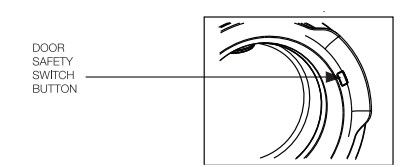
See other models: SWT8063E SWT9043
5. Clean Lint Filter
- After every load clean the lint filter located at the front of your dryer to reduce drying times and avoid overheating.
- STANDARD FEATURES
- Reversing Action
- The drum is designed to tum one minute in each direction. clockwise and anti-clockwise. This reduces tangling and gives more even drying in a shorter time.
- Cooling Down: At the end of the drying cycle. there is automatically a time of no heat. to cool down the load and minimise creasing.
Useful Hints
- Never tumble dry the following: Delicate items such as net curtains, woolen, silk, fabric with metal trim, nylon tights, bulky materials such as anoraks, blankets, eiderdown sleeping bags, feather quilts and any item containing rubber foam or materials similar to foam rubber.
- Do not place in your dryer undergarments such as bras and corsets that contain metal reinforcements. Your dryer may be damaged if metal parts were to come loose from the garment. Place such items in a bag designed for this purpose.
- For nylon socks and other small light items, place them in a bag designed for this purpose. This will stop these items being caught in the lint filter cavity.
- Check and empty pockets. Clips, pens, nails and pins can damage both the dryer and your clothes. Other items such as matches or cigarette lighter will cause a fire.
- Close all press studs, hooks, eyes and zips that may catch on something else. Tie all belts and apron strings to prevent tangling.
- Drying time will depend on fabric type and construction, load size and wetness. Save time and money and always spin the load as dry as possible in your washing machine
- Drying time will also be affected by voltage fluctuations, room temperature and humidity. Clothes will dry more slowly on a cool or humid day.
- For best results, sort the load according to fabric types. Such as heavy items which may take longer to dry, eg towels, flannelette sheets etc, than ones which dry quickly, eg poly/cotton shirts and sheets.
- Avoid drying dark clothes with light-colored items such as towels as lint will show on the dark clothes.
Note: Some fabrics will collect lint from other clothes and items. Separate the lint ‘givers’ and the lint ‘collectors' to minimize this problem. Clothes that give lint include towels, nappies, and chenille. Clothes that collect lint include corduroy, synthetics and permanent press garments.
- If individual items are still damp after drying, set a 30-minute post drying time. This will be necessary, particularly for multilayered items (eg collars, pockets, etc).
- Always clean the lint filter - this will reduce drying time and save you money.
- The laundry must be thoroughly spun before tumble drying.
- Easy-care items ep shirts should be Driefly pre-spun before drying (depending on the crease resistance approximately 30 seconds)
- To avoid static charge when drying is completed, use either a fabric softener when you are washing the laundry or a fabric conditioner specifically for tumble dryers.
- Remove the laundry when the dryer has finished drying.
- Do not over-dry laundry, this avoids creasing and saves energy.
- Clothes or towels containing sand or grit should De washed first
To help you, here is a list of the average weights of some common laundry items.
- Sheet: 700-1000g
- Tablecloth : 400 - 500g
- Kitchen towel: 70-120g
- Table napkin: 50-100g
- Toweling hand towel: 150 - 250g
- Bathrobe: 1000 - 1500g
- Men's shirt: 200-300g
- Pillowcase: 100 - 200g
- Men's pyjamas: 400 - 500g
- Ladies nightdress: 200 - 250g
- Bath towel: 300 - 400g
TROUBLESHOOTING
Check the points listed here before you call for help, and make sure that you have followed the Important Safety Information.
If you can't start your dryer check these probable causes.
- Plug is not firmly in socket, or power not turned on.
- You have blown a fuse. Check that power point with another appliance.
- You have not closed the dryer door or pushed in the door safety switch button.
- You have not turned the control knob to the setting you want.
If your clothes are still wet:
- The selected drying time was insufficient. Turn the control knob to a longer time setting.
- Longer time may be needed when the room temperature is 10°C or less.
- Check that the lint filter is not blocked.
- Check to see that you have read all the instructions carefully.
- Contact the Service Center if you are still having problems. Write down the model and serial numbers and the date of purchase before you ring. The Service Centre will need this information.
Important: To operate efficiently the clothes dryer must have an unrestricted air supply and exhaust ventilation.
Service calls resulting from installation where ventilation is restricted are not covered by warranty.
CLEANING THE LINT FILTER
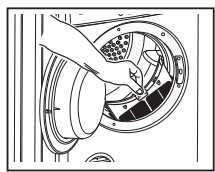
- To remove the lint filter open the door and press the two pads together. Pull the lint filter out of the pocket.
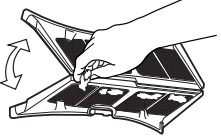
- Open apart the lint filter and wipe or peel off the lint.
- Ensure the lint filter clicks’ when replacing.
- Note : Lint filter can only be inserted one way
- Never operate your dryer without the lint filter.
- Do not allow lint to build up around your dryer.
- A tom or damaged lint filter must be replaced immediately.
- Overloading can increase lint build-up because the airflow is reduced.
- To avoid potential fire hazards, we recommend that you pay a qualified service technician to periodically clean your dryer. You must do this also when you change your mounting from upright to inverted, or vice versa.
DRYING GUIDE
Your load, when dry must not exceed the rated capacity.
- 4.5 kg for SDV457HQWA
Always check your labels for the drying symbols which the International Care Labelling Code now uses.

- Permanent press and synthetics - take out as soon as the dryer stops to reduce wrinkles.
- Woolen articles - not recommended. Pull them to their original shape, then dry them flat.
- Woven and loop knit materials - may shrink, by varying amounts, depending on their quality. Do not use the hot setting for these fabrics. Always stretch them out immediately after drying.
- Fibre or leather materials - always check the manufacturer’s instructions.
- Baby clothes and nightgowns - acrylic clothing or sleepwear use only on the warm’ setting.
- Rubber and plastics - Do not dry any items made from or containing rubber or plastics, such as aprons, bibs, babies’ waterproof napkins, curtains, tablecloths, shower caps, clothes fitted with foam rubber pads, pillows, galoshes, or rubber-coated tennis shoes.
- Fiberglass -not recommended. Glass particles left in the dryer could be picked up by your clothes the next time you use the dryer, and irritate your skin.
During the drying cycle. if you want to
- add or take out clothes, or
- check the dryness of the load, and tum down the timer to 'Airing’ for at least one minute before opening the door. This is to prevent scorching or possible self-combustion of the fabric.
Fabric softeners or similar products should not be used in a tumble dryer to eliminate the effects of static electricity unless this practice is specifically recommended by the manufacturer of the fabric softener or product.
Note: We strongly advise against the use of fabric conditioners of the sheet type that are added to the clothes in the drum. These products may lead to rapid blockage of the lint filter and inefficient operation of your dryer.
INSTRUCTIONS FOR WALL MOUNTING YOUR DRYER
- The wall or vertical surface must be strong enough to support the weight of the fully loaded dryer – approximately 45kg.
- If the dryer will be above a top loading washing machine, leave sufficient space below the dryer for the washer lid to open.
- Push the slotted tabs right in on the back panel nearest your choice of the top (can be mounted either way), using the brackets or a flat type of screwdriver.

- Existing Hoover, Westinghouse or Simpson Brackets: Remove the old brackets and replace with the new bracket, using the appropriate holes to refasten the new brackets. For Electrolux, Westinghouse and Simpson models please use the 8mm diameter holes.
- New Bracket Installation: Use the dimensions below to mark the correct location of the holes to be drilled, ensuring the distance between the brackets and the holes are all correctly aligned.
- Brick or Solid Construction Wall: Use the top holes (6.5mm diameter) to mount the bracket. Bolt the brackets directly to the wall using suitable self locking masonry fasteners, 6mm in diameter x 30mm long.
- Timber Framed Walls
- Brackets must be positioned so that they attach to the wall studs behind the plaster board or wall sheeting.
- If it is not possible to screw the brackets directly into the wall studs because they are at an inconvenient height or spacing, a timber batten (90mm x 35mm) which will span the distance between the two vertical studs is needed. Fasten the batten to the wall studs using four coach screws (6mm diameter x 70mm long). The wall brackets can then be screwed to the batten using the top two holes on each side with four coach screws (6mm diameter x 30mm long).
- If mounting the dryer on a batten, you will need to mount another piece of timber approximately 600mm long near the bottom of the dryer, in line with the two wall spacers. This will keep the dryer vertical.
- Insert the spacers at the bottom of the dryer. Push them into the key-hole slots, then rotate the spacers quarter turn to lock. (Push tabs right in)
- Note: the dryer can be mounted either way for your convenience.
- It is advisable to have a second person to assist when hanging the dryer.
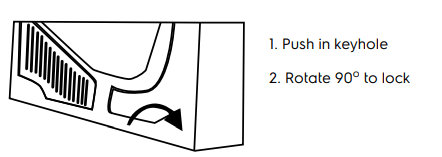
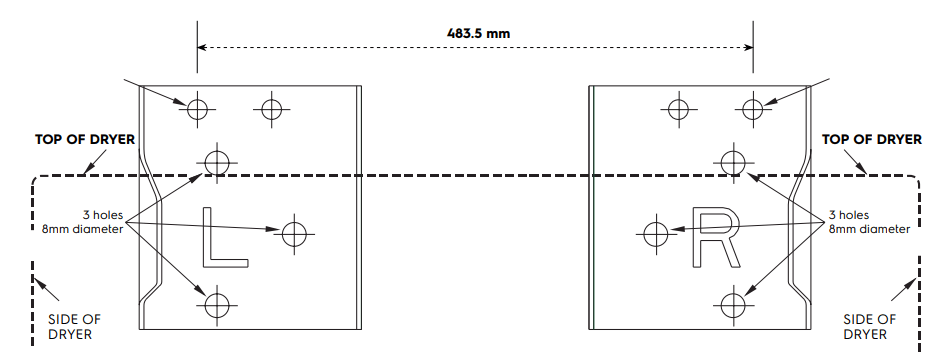
Important Safety Instructions
DRYER SAFETY
- Failure to follow these safety instructions could damage the dryer or your clothes.
- You may then not be covered by warranty for this damage.
- Only plug this appliance directly into an AC power supply, which is properly earthed and has the correct voltage. See the serial number sticker located on the top of the door opening for voltage information.

- CAUTION: If this appliance is supplied from a cord extension set or electrical portable outlet device, the cord extension set or electrical portable outlet device must be positioned so that it is not subject to splashing or ingress of moisture. For safety reasons, we strongly advise against the use of double adaptors, extension cords or power boards

- This appliance is not intended for use by persons (including children) with reduced physical. sensory or mental capabilities, or lack of experience and knowledge, unless they have been given supervision or instruction concerning use of the appliance by a person responsible for their safety.
- Children should be supervised to ensure that they do not play with the appliance.
Important
- If the electrical cord of this appliance is damaged, it must be replaced by the Manufacturer, Authorised Service similarly qualified person in order to avoid a hazard
- These dryers are for drying clothes. towels and linen at home. Do not use them for any other purpose.
- Lint must not be allowed to accumulate around the tumble dryer.
- Do not dry unwashed items in the tumble dryer.
WARNING: Never stop a tumble dryer before the end of the drying cycle unless all items are quickly removed and spread out so that the heat is dissipated.
FIRE HAZARDS
Some fabrics are not suitable for tumble drying. The following MUST NOT be placed in your dryer due to the risk of a fire or an explosion:
- Items that have been spotted or soaked with vegetable oil. cooking oil. suntan oil. linseed oil. salad oil. lubrication oil or grease. Oil-affected items can ignite spontaneously. especially when exposed to heat sources such as in a tumble dryer. The items become warm. causing an oxidation reaction in the oil. Oxidation creates heat. If heat cannot escape. the items can become hot enough to ignite. Piling. stacking. or storing oil-affected items can prevent heat from escaping and create a fire hazard. If it is unavoidable that fabrics that contain vegetable or cooking oil. or have been contaminated by hair care products be placed in a tumble dryer. they should first be washed in hot water with extra detergent this will reduce, but not eliminate the hazard. The cool-down cycle of tumble dryers should be used to reduce the temperature of the items. They should not be removed from the tumble dryer or piled while hot.
- Items that have previously been cleaned in, washed in, or spotted with petrol/gasoline, industrial chemicals used only for cleaning, dry-cleaning solvents or other flammable or explosive substances. Highly flammable substances commonly found around the house include acetone. (nail polish remover) denatured alcohol, petrol/gasoline, kerosene, some spot removers. turpentine. waxes and wax removers. Items containing foam rubber (also known as latex foam) or similarly textured rubber-like materials. Foam rubber materials can produce fire by spontaneous combustion when heated.
- Rubber-backed articles. clothes fitted with foam rubber pads, pillows, rubber boots and rubber-coated sports shoes.
For your safety. and to reduce the risk of fire or an explosion. DO NOT store or use petrol or other inflammable vapors and liquids near your dryer.
LINT BUILD-UP IS A FIRE HAZARD.
- A clean lint filter reduces drying times. saves energy and avoids overheating. Overheating may also damage your clothes.
- What happens if forget to clean the lint filter?
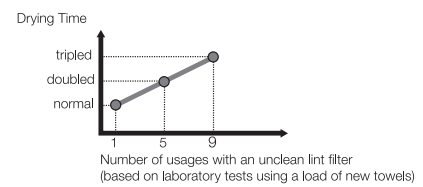
- The lint filter is located at the front of your dryer at the bottom. of the door opening.
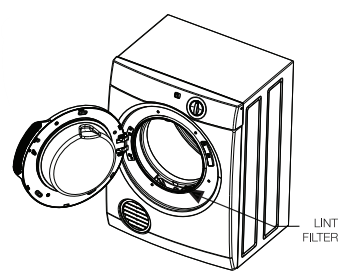
You must clean this lint filter after every load.
